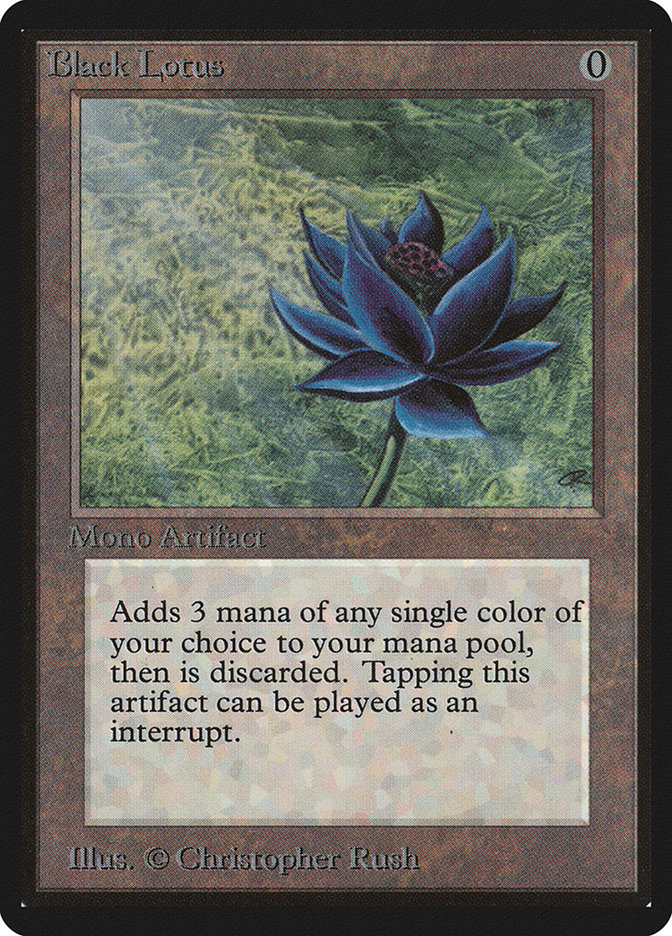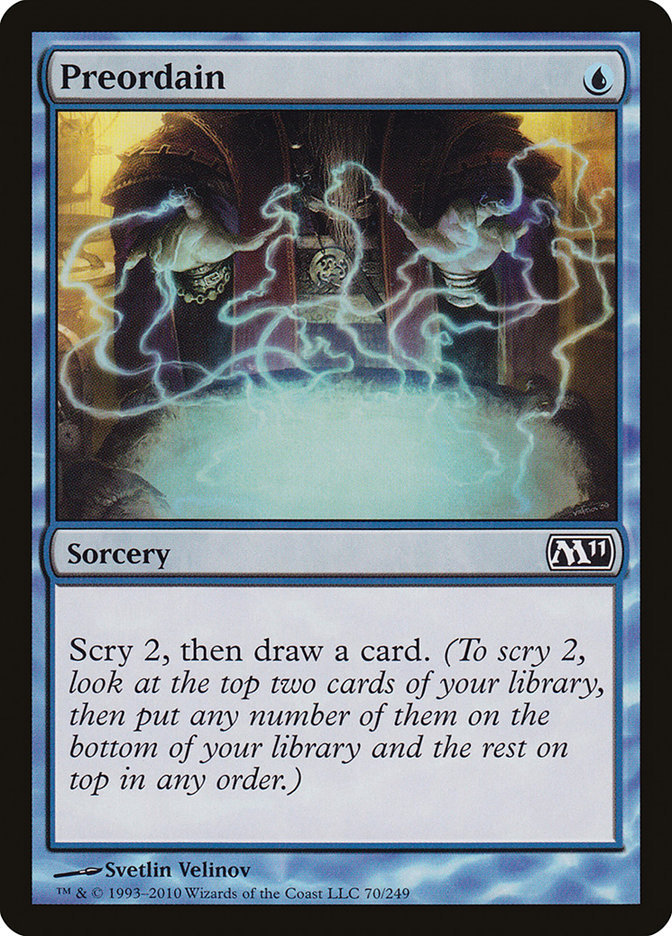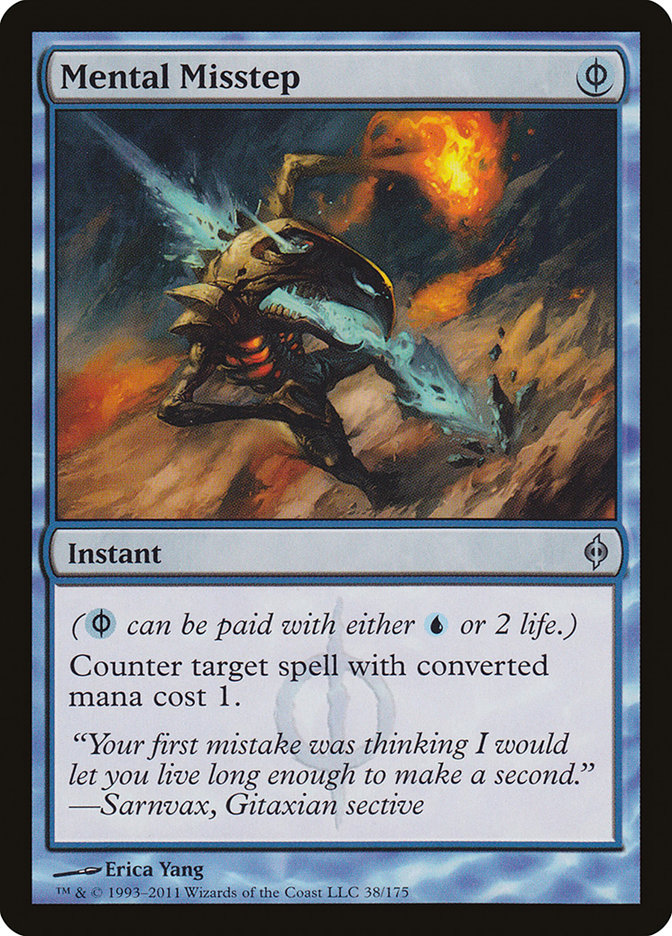Sphinx’s Revelation for ten, Splinter Twin on a Deceiver Exarch, Show and Tell in Emrakul—none of it really compares to the feeling you get when you play Vintage. Part of it is the fast pace and the explosiveness of the format, but more than anything it’s about the possibilities! With the amount of card draw, library manipulation, and tutor effects available to players, each turn presents you with a limitless number of options and a tremendous amount of control over what happens in the game. What’s more is that the giant card pool and the limits put on the format by the restricted list means a ton of diversity in the number of cards that see play. My Vintage deck contains 45 distinct cards, and that’s only in the maindeck!
I personally had never bought into the old roleplay of Magic players being planeswalkers battling one another for supremacy. That said, playing Vintage genuinely does give you the feeling of being a powerful wizard!
So it was with great excitement that I unexpectedly found myself driving to Philadelphia on Sunday morning for the Vintage Championships. Before last Sunday, I was not a Vintage player. And besides, for many days preceding, I’d looked forward to having a weekend off—off from traveling and off from the physical, mental, and emotional strain of big tournaments. However, when on Saturday my good friend Jeff Englert, store manager of Toywiz in Nanuet, New York, offered to lend me the power cards I needed to play Vintage, I decided that it was a unique opportunity that I shouldn’t miss.
I was right.
The Vintage Community
The first thing that struck me about playing Vintage—well, after the thrilling gameplay of the format—was the welcoming nature of the community. This tournament really stands out in my mind for remarkably pleasant matches with no judge calls or bad feelings. I had one or two opponents that were very reserved and about whom I have nothing really to say either good or bad; all of the rest of them were a genuine pleasure to play with. For the whole day, none of my opponents were rude to me, none pressured me for time (not that I would blame someone for doing so), and none complained about luck. To my knowledge, there were no reports of theft at the event.
While most Magic players mean well, my experience is that the PTQ and Grand Prix grind can be very draining and can lead to some players becoming embittered, cutthroat, or "sick of losing." The Vintage community, on the flip side, seems to be made up more of occasional players who really love what they’re doing. So I’d like to both thank the Vintage community for being so welcoming and encourage others to try the Vintage experience, whether that means acquiring power cards, choosing an unpowered deck, playing a proxy tournament, or simply going to spectate a few matches.
My Previous Experience
I said that I myself was not a Vintage player, but that’s not a hundred percent true. I actually played quite a lot of Vintage around 2008 when I was a freshman/sophomore in college. Back then I eagerly read all of Vintage expert Stephen Menendian articles that you can still find on this very website. I picked up what was called Grim Long, a combo deck whose most common route to victory was to generate mana, Grim Tutor for Yawgmoth’s Will, generate a lot more mana, flashback the Grim Tutor, and Tendrils of Agony the opponent for a lethal amount. After half a dozen tournaments and a year of practice, I’d say I was one step removed from being an expert with the deck. (To borrow from Ultima Online’s rating system, I was a "Journeyman Storm Combo Player.")
But this was five years ago. It was before the printing of Jace, the Mind Sculptor. It was before Spell Pierce, before Flusterstorm, and before Mental Misstep. At first I was worried that traditional Storm Combo was an extinct archetype.
However, it dawned on me that Vintage is a format that’s pretty slow to change; after all, before it was called Vintage, it was called Eternal. It turns out that Black Lotus is still good.
In all seriousness, Vintage decklists tend to be mercilessly tight. No matter how efficient these new counterspells are, most players only find room for one or two copies of each, and even that eats into slots that used to be Mana Drains or Thoughtseizes.
So I fired up [author name="Brian DeMars"]Brian DeMars[/author]‘ most recent article for a crash course on 2013 Vintage and dusted off my Dark Rituals. It was incredible how quickly things began to come back to me: tips and tricks, common pitfalls, aspects of the decklist that I liked and disliked, etc. I updated my old decklist with four copies of Gitaxian Probe and one copy of Mental Misstep and went to try my luck.
Storm Combo
Creatures (1)
Lands (12)
Spells (47)
- 1 Tendrils of Agony
- 1 Brainstorm
- 1 Cabal Ritual
- 1 Yawgmoth's Bargain
- 1 Vampiric Tutor
- 1 Mystical Tutor
- 1 Yawgmoth's Will
- 4 Duress
- 1 Necropotence
- 1 Mana Vault
- 1 Wheel of Fortune
- 1 Sol Ring
- 1 Demonic Tutor
- 1 Hurkyl's Recall
- 1 Time Walk
- 4 Dark Ritual
- 1 Ancestral Recall
- 1 Imperial Seal
- 1 Grim Tutor
- 1 Mana Crypt
- 1 Windfall
- 1 Timetwister
- 1 Mind's Desire
- 1 Memory Jar
- 1 Chain of Vapor
- 1 Tinker
- 1 Black Lotus
- 1 Lotus Petal
- 1 Lion's Eye Diamond
- 1 Mox Emerald
- 1 Mox Jet
- 1 Mox Pearl
- 1 Mox Ruby
- 1 Mox Sapphire
- 1 Chrome Mox
- 1 Ponder
- 1 Mental Misstep
- 4 Gitaxian Probe

My philosophy has always been and will likely remain that the best way to get the real Vintage experience is to play the most broken deck with the highest concentration of restricted cards!
Now, if you’re unfamiliar with Vintage and you’re anything like me, then I’m sure the question at the forefront of your mind is "how fast can a fully powered combo deck kill?" Well, I can offer some imprecise numbers based on my own experience.
Vintage Storm Combo: Win Speed Against A Goldfish
Win on turn 1: 15-20% of games
Win by turn 2 (aka win on turn 1 or on turn 2): 45-55% of games
Win by turn 3: 75-85% of games
All things considered, the deck is not that fast. It’s marginally faster than Dredge and noticeably slower than Belcher. It’s not even worlds different from Legacy Ad Nauseam in terms of speed. However, Vintage Storm is infinitely more resilient than these decks.
When I think of Storm in Legacy, I think of building a house of cards as high as I can go. I ritual, ritual, ritual, ritual, and then go for it, but just like when I place a card an inch off the mark, when my Ad Nauseam gets countered, everything collapses into nothing! This is not the case with Vintage Storm because your mana sources are better and your threats are cheaper.
One of my favorite things about Vintage Storm are the "draw sevens": Timetwister, Wheel of Fortune, Windfall, and Memory Jar. Not only are these cards very explosive and very fun to play with, but they put the opponent in a very awkward position. If your opponent has a counterspell, they must use it on your draw seven because otherwise they’ll simply lose it.
"Okay, I’ll go first. Land, Mox, Mox, Wheel of Fortune. Is that okay?"
Here, the best-case scenario for your opponent is that they have a Force of Will. In this case, you’ve Hymn to Tourached them and hit their best card against you.
The second-best case for the opponent is that the Wheel of Fortune resolves and you say go. In this case, you’ve forced them to mulligan their hand into one they have absolutely zero control over and you have three free permanents in play!
The worst-case scenario for the opponent is that you draw seven fresh cards and continuing comboing off, perhaps on your way to a first-turn kill.
It’s not only the draw sevens that represent cheap devastating plays. There’s also Ancestral Recall, Necropotence, and Yawgmoth’s Will, and every single one of your five Tutors can instantly become one of these spells.
Finally, there’s the presence of the storm mechanic and the fact that Mind’s Desire is a very different card from Ad Nauseam. With Ad Nauseam, the opponent knows exactly when to use their counter—once you’ve finished ritualing and are ready to cast your Ad Nauseam. With Mind’s Desire, the question is much more complicated; if they wait a moment too long to pull the trigger, it will be too late.
Against my poor opponent in round 1, I cast Gitaxian Probe and saw a Force of Will and a blue card. He picked up his hand, and then I cast . . .
Please take a moment and consider this—the next time your opponent does this to you, will you counter the Lotus?
If you answered "yes," well, you were wrong. Your opponent had a hand of all mana, and you really needed to save your Force of Will for his one business spell, which was Yawgmoth’s Bargain!
If you answered "no," you were also wrong. This time you gave your opponent the blue mana he needed to cast a Mind’s Desire with a huge storm count, and your Force of Will became useless!
Deal with it.
The complexity of Vintage Storm can feel mentally taxing for its pilot, but just as often it’s presenting the opponent with tough decisions. Sometimes it’s correct to let a Tutor resolve and counter the spell that the Storm player searched for. Other times they go search for an uncounterable card like a Tolarian Academy or a Mind’s Desire, and you’re in trouble. The problem is that it can be very difficult to know which situation you’re facing.
Storm In The Vintage Metagame
Brian DeMars‘ article laid out an overview of the current Vintage metagame. He named four decks as pillars of the format that you should expect to face on your way to winning a Vintage tournament. They are in essence Dredge, Mishra’s Workshop decks, blue control decks, and blue creature decks.
Certainly the presence of Dredge should not scare anyone away from playing Storm. You have a fine chance to win game 1 simply by racing, and you can sideboard plenty of cards against them, while they cannot sideboard much against you.
Mishra’s Workshop decks can be tricky for Storm, as they have access to cards like Sphere of Resistance and Chalice of the Void. However, I remember working a lot on the matchup back in the day and beginning to feel favored once I developed a realistic plan. I would sideboard in basic lands and try to just develop mana for a few turns without getting Wastelanded. Then, at the last possible moment, I would bounce all of their disruptive artifacts with Hurkyl’s Recall or Rebuild and combo off. Additionally, I would sideboard in some sleek efficient win conditions like Empty the Warrens and Tinker for Blightsteel Colossus, which could sometimes come down before the disruption and steal games.
Granted, the Workshop decks have improved since 2008; they now have the deadly Lodestone Golem, which represents both disruption and a fast clock at the same time. Nonetheless, as Storm you can still get draws where there’s nothing the Workshop player can do to stop you. I only faced Workshop once at Vintage Champs and won, but without more experience I don’t feel qualified to offer any statistics about which deck ought to win the matchup more often.
From looking up and down the tables over the course of the day, Mr. DeMars’ assessment appeared to be spot on. However, for whatever reason (dumb luck, I suppose), my personal matchups did not reflect the diversity of the Vintage metagame. In the ten rounds I played, eight of my opponents were playing blue decks featuring Force of Will.
These matchups felt close but usually favorable depending on the opponent’s exact deck. As mentioned above, you have such a high density of spells that must be countered, and it’s typically not that devastating for you if they are countered. Additionally, your "counter-disruption" package of Mental Misstep, Duress / Thoughtseize, and Red Elemental Blast matches or exceeds their counters in terms of efficiency. Typically it’s not too difficult to find a route to victory and force your way through.
Potential Changes
As you might have predicted, my decklist was not spot on perfect the first go-around. I had one or possibly even two too many lands in my maindeck. I was also a tiny bit light on business spells, especially considering that I like to sideboard out Windfall on the draw and the Tinker + Memory Jar package against dedicated permission decks. To smooth things out, I would have liked a couple of Preordains.
Mental Misstep is a very difficult card to evaluate. It wasn’t bad for me but also didn’t feel completely necessary. It’s good for countering Spell Pierce and opposing Mental Missteps, but I was shocked at how few Thoughtseizes and Duresses I had to face over the course of the day.
I’m not sure what the perfect counter-disruption package is, but diversity is good. Storm should have access to four-to-six Duress effects, one-to-three Red Elemental Blast effects, and zero-to-two Mental Missteps between maindeck and sideboard.
Here’s what I’d play for next time:
Lands (11)
Spells (49)
- 1 Tendrils of Agony
- 1 Brainstorm
- 1 Cabal Ritual
- 1 Yawgmoth's Bargain
- 1 Vampiric Tutor
- 1 Mystical Tutor
- 1 Yawgmoth's Will
- 4 Duress
- 1 Necropotence
- 1 Mana Vault
- 1 Wheel of Fortune
- 1 Sol Ring
- 1 Demonic Tutor
- 1 Hurkyl's Recall
- 1 Time Walk
- 4 Dark Ritual
- 1 Ancestral Recall
- 1 Imperial Seal
- 1 Grim Tutor
- 1 Mana Crypt
- 1 Windfall
- 1 Timetwister
- 1 Mind's Desire
- 1 Memory Jar
- 1 Chain of Vapor
- 1 Tinker
- 1 Black Lotus
- 1 Lotus Petal
- 1 Lion's Eye Diamond
- 1 Mox Emerald
- 1 Mox Jet
- 1 Mox Pearl
- 1 Mox Ruby
- 1 Mox Sapphire
- 1 Chrome Mox
- 1 Ponder
- 2 Preordain
- 1 Mental Misstep
- 4 Gitaxian Probe

Wrapping It All Up
I don’t believe that Storm Combo is the best deck in the format, but I was impressed by its ability to stand the test of time and think it’s currently underrepresented in the metagame.
For players who really want to beat the deck, it’s relatively straightforward to do so. Simply pack your deck with as much permission and other disruption as possible. A mix of permission, hand destruction, and permanent sources of disruption like Null Rod is the most effective. That said, until people start doing these things, Storm is a perfectly fine choice for a Vintage tournament.
So I finished Vintage Champs in fourth place, which I was thrilled with! While it would have been incredible to win the entire tournament, I certainly exceeded my own expectations. Plus, a great prize for making Top 8 was simply the opportunity to play two extra matches of this great format. Thanks again to my friends at Toywiz for providing the cards I needed to play the event!
I truly had a blast playing Vintage last weekend. I really encourage anyone who has never played the format to try their hand at least one time. Even though competitive events in Vintage tend to be few and far between, I believe that the challenging gameplay of the format can help develop skills that will be useful to any Magic player. Think of it as cross-training for Legacy, Modern, or even Standard and Limited!
And on a personal note, I hope it won’t be another five years before I get to dust off my Necropotence!



